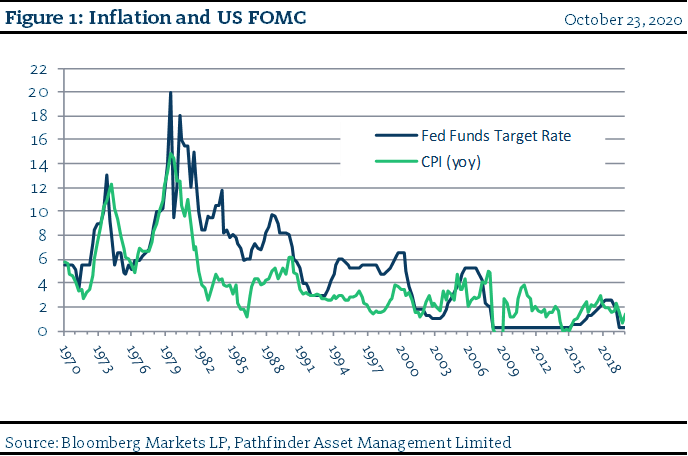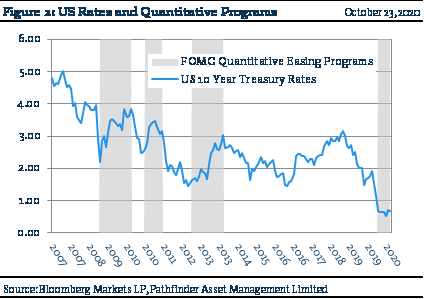Central Banks Now Need Government Cooperation
Since 1913, the United States Federal Open Market Committee (FOMC), which is a collection of regional Federal Reserve Bank Chairmen and Chairwomen, has been attempting to manage the US business cycle. More recently, they have been focused on a dual mandate of price stability (inflation) and maximum sustainable employment. Stable inflation has traditionally been defined as 2% per annum, while full employment has traditionally been defined as an unemployment rate below 5%. Many readers will remember the 1970’s when inflation was much higher (just under 15% year on year) and Paul Volker, FOMC Chair at that time, raised administered rates to 20% in March of 1980 to bring inflation under control. It took 5 years to accomplish that task (please see Figure 1).
After the commodity boom of the early 2000’s came the Great Financial Crisis. As administered rates and inflation were already somewhat lower, central banks started to use alternative measures (called quantitative easing or tightening) in attempt to impact the business cycle. This included purchasing bonds and mortgage backed securities in order to provide liquidity but also in attempt to further decrease interest rates with the goal of sparking economic activity. Figure 2 presents the time periods and fixed income rates during the multiple quantitative easing periods from 2009 through 2015.
- Further review of Figure 1 shows the decreasing highs of the administered rates indicating a structural decrease in the ability of US monetary policy to influence the business cycle. This makes sense if you think about it in the context of your own mortgage. If mortgage rates get cut in half from 10% to 5%, people will buy a house and/or potentially move to a larger more expensive home; however, a 50% drop in mortgage rates from 4% to 2% does little to incentivize already overly indebted homeowners to further purchase again.

- Figure 2 shows that interest rates, even with quantitative easing, have dropped over time and are now at new lows. Given the lackluster performance of the economy, this puts in questions the effectiveness of future monetary policy.

“This means that” we have become less confident in the FOMC’s ability to influence the current economic situation with monetary policy. While we believe that the committee will be able to provide sufficient liquidity to keep the financial system functioning normally, fiscal policy, promulgated by federal governments will be the only stimulus that truly impacts the ongoing economic situation.
National Instrument 31-103 requires registered firms to disclose information that a reasonable investor would expect to know, including any material conflicts with the firm or its representatives. Doug Johnson and/or Pathfinder Asset Management Limited are an insider of companies periodically mentioned in this report. Please visit www.paml.ca for full disclosures.
*All returns are time weighted and net of investment management fees. Returns from the Pathfinder Partners’ Fund and Pathfinder Real Fund are presented based on the masters series of each fund. The Pathfinder North American Equity Portfolio and The Pathfinder North American Income Portfolio are live accounts. These are actual accounts owned by the Pathfinder Chairman (Equity) and client (High Income) which contain no legacy positions, cash flows or other Pathfinder investment mandates or products. Monthly inception dates for each fund and portfolio are as follows: Pathfinder North American Equity Portfolio (January 2011), Pathfinder North American High-Income Portfolio (October 2012) Pathfinder Partners’ Fund (April 2011), Pathfinder Real Fund (April, 2013), and Pathfinder International Fund (November 2014).
Pathfinder Asset Management Limited (PAML) and its affiliates may collectively beneficially own in excess of 10% of one or more classes of the issued and outstanding equity securities mentioned in this newsletter. This publication is intended only to convey information. It is not to be construed as an investment guide or as an offer or solicitation of an offer to buy or sell any of the securities mentioned in it. The author has taken all usual and reasonable precautions to determine that the information contained in this publication has been obtained from sources believed to be reliable and that the procedures used to summarize and analyze such information are based on approved practices and principles in the investment industry. However, the market forces underlying investment value are subject to sudden and dramatic changes and data availability varies from one moment to the next. Consequently, neither the author nor PAML can make any warranty as to the accuracy or completeness of information, analysis or views contained in this publication or their usefulness or suitability in any particular circumstance. You should not undertake any investment or portfolio assessment or other transaction on the basis of this publication, but should first consult your portfolio manager, who can assess all relevant particulars of any proposed investment or transaction. PAML and the author accept no liability of any kind whatsoever or any damages or losses incurred by you as a result of reliance upon or use of this publication.